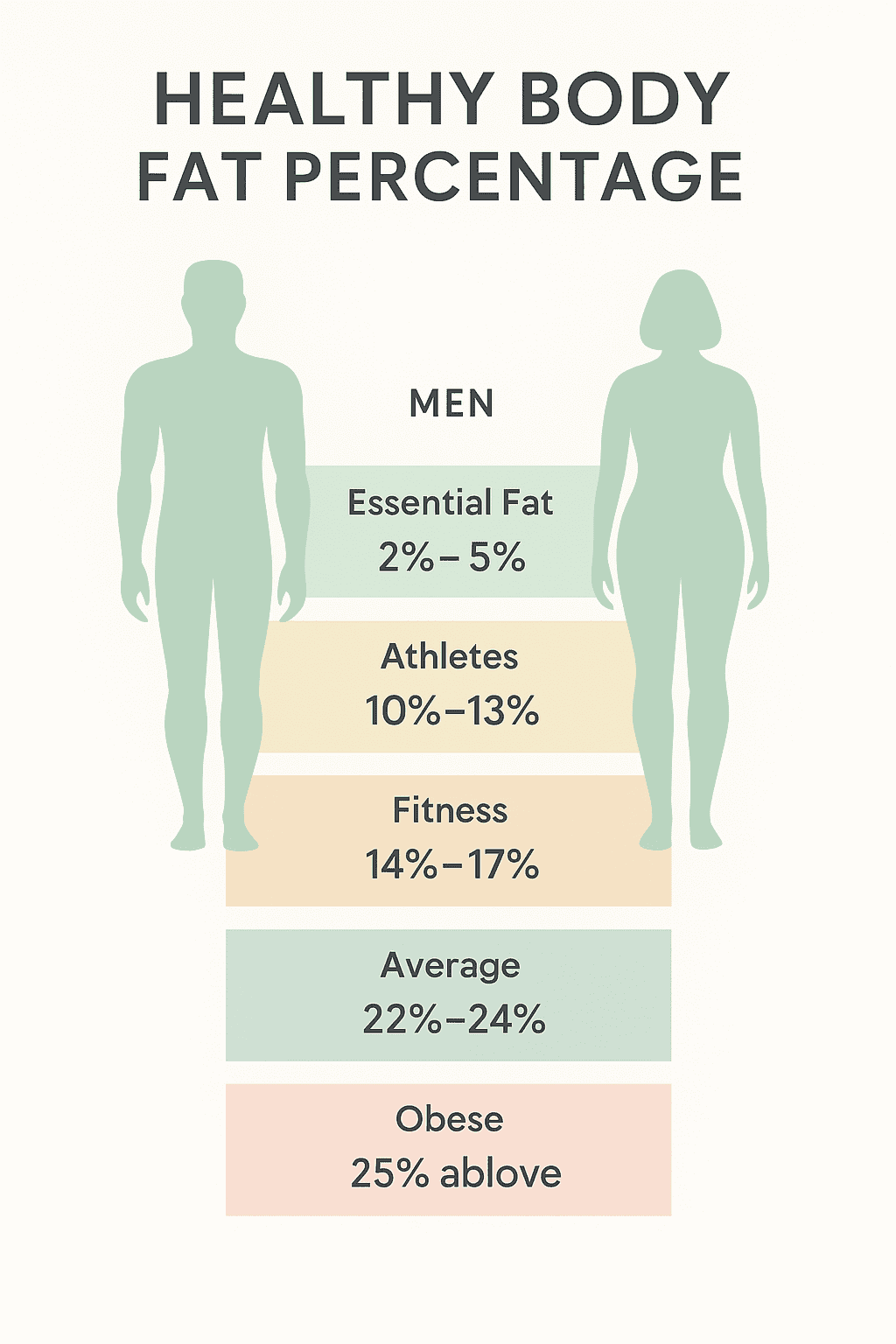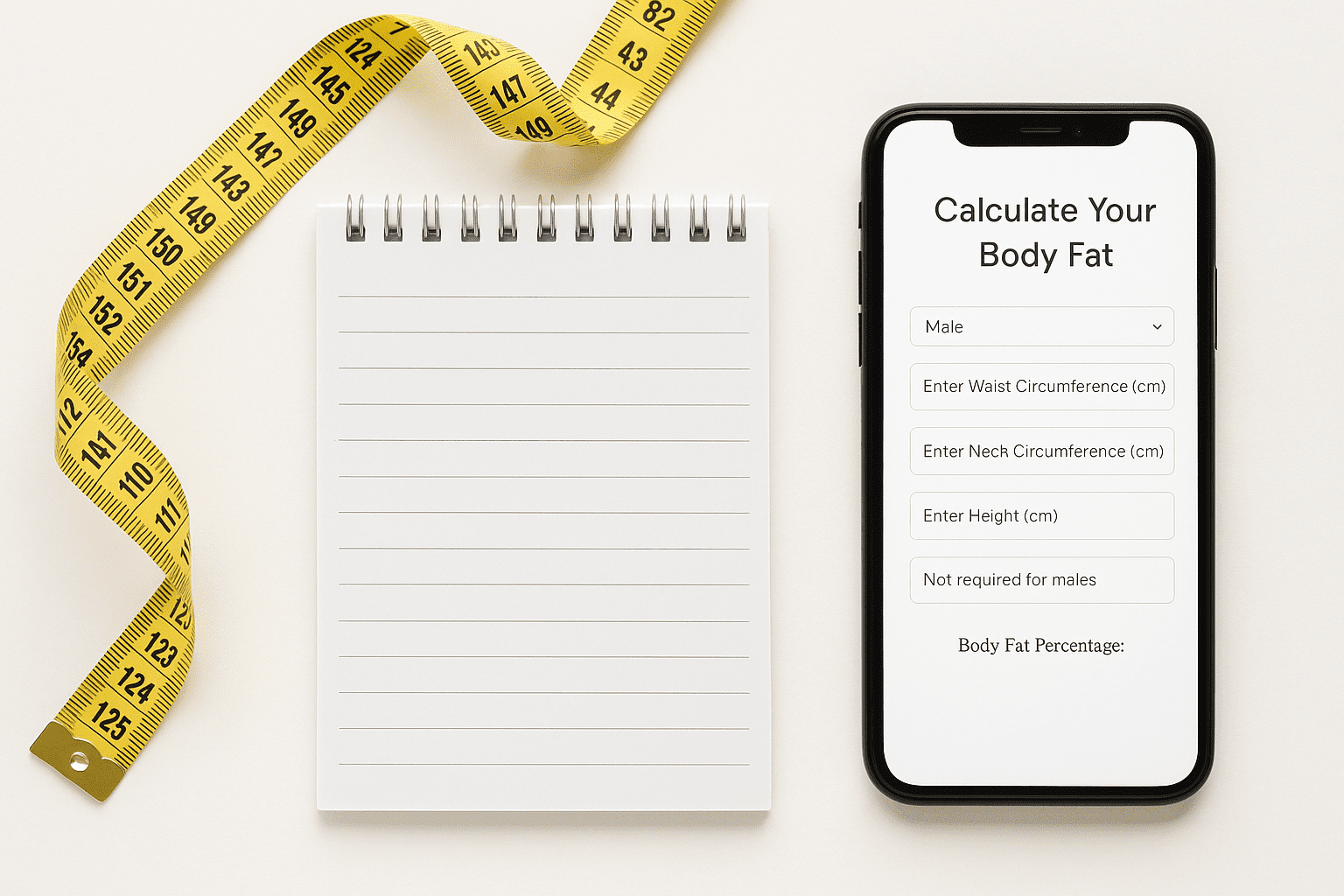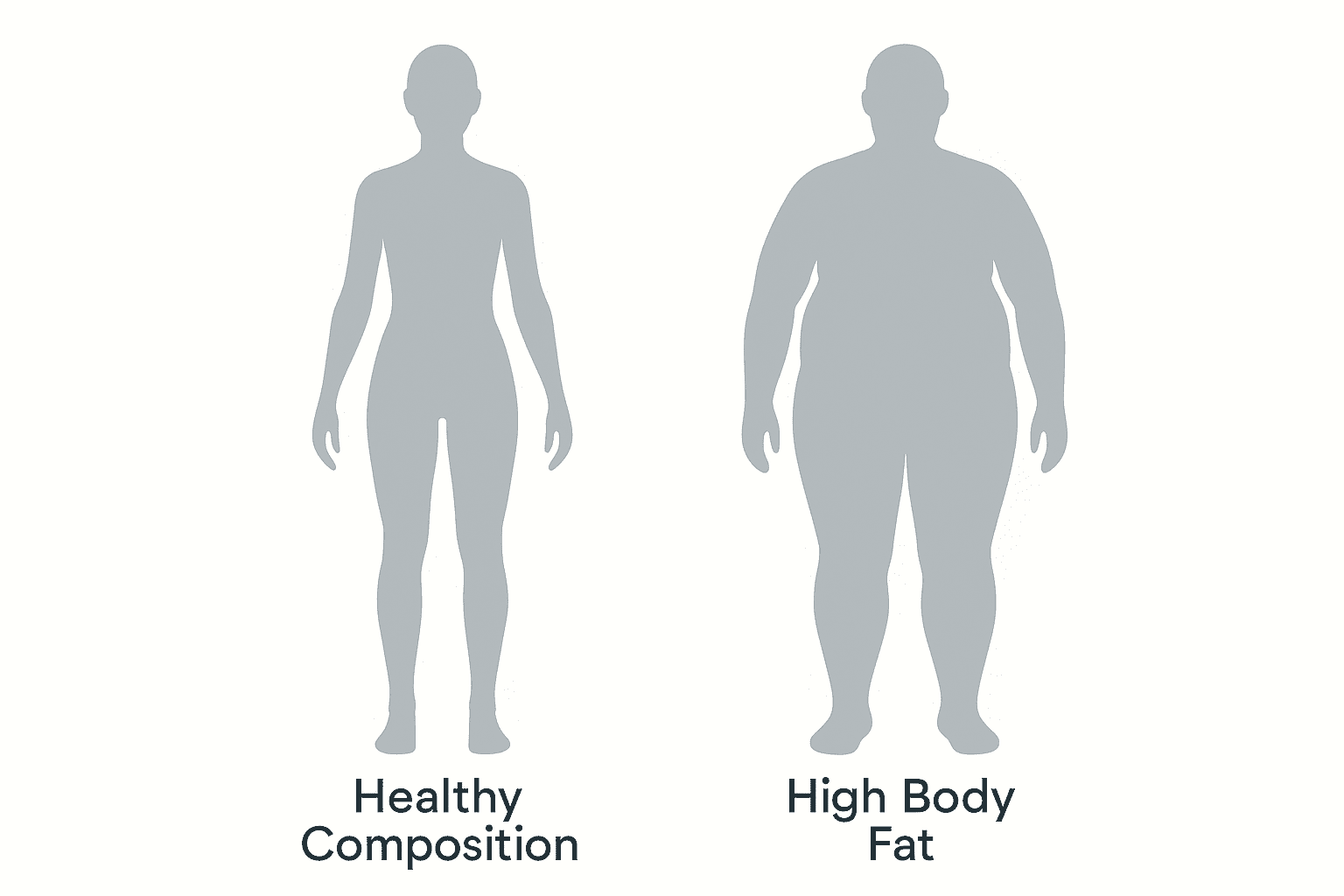Calculate Your Body Fat
Body Fat Percentage:
See beyond the scale. Estimate your body fat percentage using trusted methods, track composition changes, and plan smarter nutrition and training.

Weight alone does not tell the whole story. Two people may weigh the same, yet one can be muscular and fit while the other carries more body fat. Body composition is the difference. To understand this clearly, use a body fat calculator.
NutriFitCalc Body Fat Calculator helps you see beyond the scale. Your body fat percentage is more informative than kilograms or pounds. It is often more useful than a simple weighing scale or a BMI chart for personal tracking, because it clarifies whether weight is primarily lean mass or fat.
Higher body fat can signal risks such as insulin resistance, diabetes, and hormone imbalance. Very low body fat can also reduce energy, disrupt hormones, and weaken immunity. Balance is key. Tracking body fat regularly helps you make better choices and monitor real progress.
Try it free: NutriFitCalc Body Fat Calculator. It is fast and easy to use.
What Is a Body Fat Calculator?
A body fat calculator estimates how much of your body weight comes from lean tissues such as muscle, bone, organs, and water compared with fat. It uses mathematical formulas based on circumference measurements such as waist, neck, height, and for women, hip.
Method used: NutriFitCalc Body Fat Calculator utilizes the U.S. Navy Method, a widely trusted approach refined over decades to provide accurate estimates without advanced equipment.
- Men: measurements include waist, neck, and height.
- Women: include waist, hip, neck, and height for better accuracy.
This approach is ideal when DEXA or other professional body composition scanners are not available. It is useful for athletes and home users beginning their fitness journey.
The World Health Organization emphasizes that body composition is more informative than weight alone. People with the same BMI can have very different fat percentages.
Use the BMI Calculator together with the Body Fat Calculator for a complete view.
Why Body Fat Percentage Matters More Than Weight
Weight does not define health. Composition does. You can be light but carry excessive fat, or heavy because of dense muscle. Body fat percentage helps reveal whether your weight reflects healthy lean mass or hidden risks.
Research from Harvard Health notes that people with a normal BMI but high body fat can face risks similar to those with obesity, especially when fat is concentrated in the abdomen. Read more at Harvard Health.
Why tracking body fat is important
- Distinguishes between fat and muscle.
- Tracks progress accurately. If weight stays the same but body fat does not decrease, you may be losing muscle instead of fat.
- Helps set realistic goals and personalize nutrition and training.
- Increases awareness of visceral fat risks.
Cross-check results with the Calories Burned Calculator to plan daily intake that promotes fat loss while maintaining muscle.
Healthy Body Fat Ranges
Typical ranges based on the American Council on Exercise:
| Category | Men | Women |
|---|---|---|
| Essential Fat | 2–5% | 10–13% |
| Athletes | 6–13% | 14–20% |
| Fitness | 14–17% | 21–24% |
| Average | 18–24% | 25–31% |
| Obese | 25%+ | 32%+ |
Falling into the fitness range is ideal for many people, but age, sex, and activity level matter. Use the calculator regularly and adjust nutrition and training accordingly.

How the NutriFitCalc Body Fat Calculator Works
The NutriFitCalc tool uses the U.S. Navy Body Fat Equation, a validated and widely adopted method for non invasive estimation.
Men: % Body Fat = 86.010 × log10(waist − neck) − 70.041 × log10(height) + 36.76
Women: % Body Fat = 163.205 × log10(waist + hip − neck) − 97.684 × log10(height) − 78.387
The calculator interprets your measurements to estimate fat distribution and percentage. Its accuracy has been examined by institutions including the U.S. Department of Defense.
How to measure correctly
- Use a flexible measuring tape.
- Stand upright and relaxed.
- Waist: narrowest point above the navel.
- Neck: just below the Adam’s apple.
- Women: hip at widest point.
Enter values into the Body Fat Calculator to see your percentage and classification instantly. If you are also tracking BMI, you can switch between calculators:
Body Fat Calculator and BMI
BMI classifies weight status using height and weight, but it does not separate lean mass from fat. This can misclassify individuals.
- An athlete with BMI 28 may be labeled overweight but have only 10 percent body fat.
- A sedentary person may have BMI 22 yet carry 30 percent body fat, which is unhealthy.
According to the CDC, BMI is useful for population level assessment, but it is limited for individual body composition tracking. For personal goals, tools like the NutriFitCalc Body Fat Calculator provide more relevant detail. CDC guidance.
Use both calculators together
- BMI Calculator for quick classification
- Body Fat Calculator for accurate composition tracking
Together they provide a clearer and more scientific view of health.
Ways to Measure Body Fat
- Online Calculators
- NutriFitCalc uses circumference based equations. Free, fast, and practical for home tracking.
- Skinfold Calipers
- Measure skinfold thickness at several sites. Accuracy depends on correct technique.
- Bioelectrical Impedance Analysis
- Common in smart scales. Results can vary with hydration state.
- DEXA Scan
- Medical grade analysis of bone, fat, and lean mass. Accurate, but availability and cost can be limiting.
- Hydrostatic Weighing and Bod Pod
- Estimate body density by water or air displacement. Precise, but not practical for most users.
The NutriFitCalc Body Fat Calculator blends convenience with science. Pair it with the Calories Burned Calculator to plan a caloric balance that promotes fat loss while protecting lean mass.
Understanding Body Composition

Body composition is the ratio of lean mass to fat mass. Fitness is better reflected by composition than weight.
- Lean mass: muscle, bone, organs, and water.
- Body fat: essential and stored fat.
Higher lean mass supports a robust metabolism. Higher fat mass raises risk for chronic disease. The CDC notes that understanding body composition can help prevent metabolic disorders. CDC on body fat.
Visceral fat can remain hidden even when BMI appears normal. It accumulates around organs and carries greater health risk.
Improve composition
- Prioritize protein rich meals.
- Stay active with cardio and resistance training.
- Track weekly with the Body Fat Calculator.
- Set long term targets with the Ideal Weight Calculator.
What Is Visceral Fat?

Visceral fat is deep abdominal fat that wraps around organs and releases inflammatory chemicals. It is more harmful than subcutaneous fat under the skin.
High visceral fat is associated with type 2 diabetes, high cholesterol, heart disease, hormonal imbalance, and elevated blood pressure. Even at a normal weight, a large waist relative to height and neck circumference can indicate higher risk.
Use the Body Fat Calculator to monitor trends. Combine with the Calories Burned Calculator to reduce fat through gradual caloric control and regular activity.
Factors That Affect Body Fat Percentage

- Diet quality: frequent sugary drinks and ultra processed foods raise fat gain risk.
- Exercise level: strength training and cardio improve metabolism.
- Hormones: imbalances in cortisol or insulin affect fat distribution.
- Sleep: short sleep raises appetite hormones and reduces fat burning efficiency.
- Stress: chronic stress elevates cortisol and encourages belly fat storage.
- Hydration: low hydration can affect measurements and metabolism.
The WHO recommends combining regular activity with balanced nutrition for sustainable fat reduction. WHO healthy diet
Reduce Your Body Fat Percentage Safely
Combine moderate calorie reduction with regular physical activity. Extreme diets can reduce muscle and slow metabolism.
- Calculate calories: estimate needs and aim for a 10 to 20 percent deficit with the Calories Burned Calculator.
- Prioritize protein: lean meats, fish, legumes, nuts, beans, and eggs help preserve muscle during fat loss.
- Strength train: resistance work increases lean tissue and supports long term fat burning.
- Add cardio: walking and interval training help burn fat.
- Be consistent: track weekly with the Body Fat Calculator rather than day to day fluctuations.
- Rest and hydrate: recovery and hormone balance matter.
Harvard Health highlights that sustainable habits outperform short term dieting for fat loss. Harvard on healthy weight
The Importance of Tracking Regularly
Tracking body fat acts like a periodic health check. It confirms whether your nutrition and training strategies are working.
- Detect early signs of weight gain.
- Verify that weight loss comes from fat, not muscle.
- Stay motivated with measurable results.
- Adjust plans based on data.
Combine the Body Fat Calculator with the BMI Calculator and the Ideal Weight Calculator for a comprehensive view of progress.
Build Fitness the Smart Way
Your approach should be personal. The Body Fat Calculator gives you accurate data as your lifestyle improves.
- Calculate your BMI for classification.
- Use the Calories Burned Calculator for planning.
- Set targets with the Ideal Weight Calculator.
Together with consistent habits, these tools help you manage weight, avoid health problems, and build a strong, balanced body.
FAQs — Body Fat Calculator
What is a Body Fat Calculator?
It estimates the percentage of your body weight that is fat using measurements such as waist, neck, height, and for women, hip. It provides a practical view of composition at home.
How accurate is the NutriFitCalc Body Fat Calculator?
It is based on the U.S. Navy equation, which has been scientifically validated for estimation. It is not as precise as laboratory scans such as DEXA or hydrostatic weighing, but it is practical and consistent for personal tracking.
What body fat percentage is healthy for men and women?
Many men and women aim for roughly 10 to 20 percent depending on body type and goals. Use the calculator and related tools on NutriFitCalc to monitor progress and personalize targets.
What is the safest way to reduce body fat?
Combine regular strength training and cardio with a calorie controlled diet. Estimate needs with the Calories Burned Calculator and maintain a moderate deficit.
What is the difference between body fat and visceral fat?
Body fat includes subcutaneous and visceral fat. Visceral fat surrounds organs and carries higher health risks. Monitoring waist and using composition tools helps identify concerns.
Can I estimate body fat at home?
Yes. Use the NutriFitCalc Body Fat Calculator by entering basic measurements for instant results.
How often should I check my body fat?
Every two to four weeks is a good cadence. This shows trends without being affected by short term fluctuations from food or hydration.